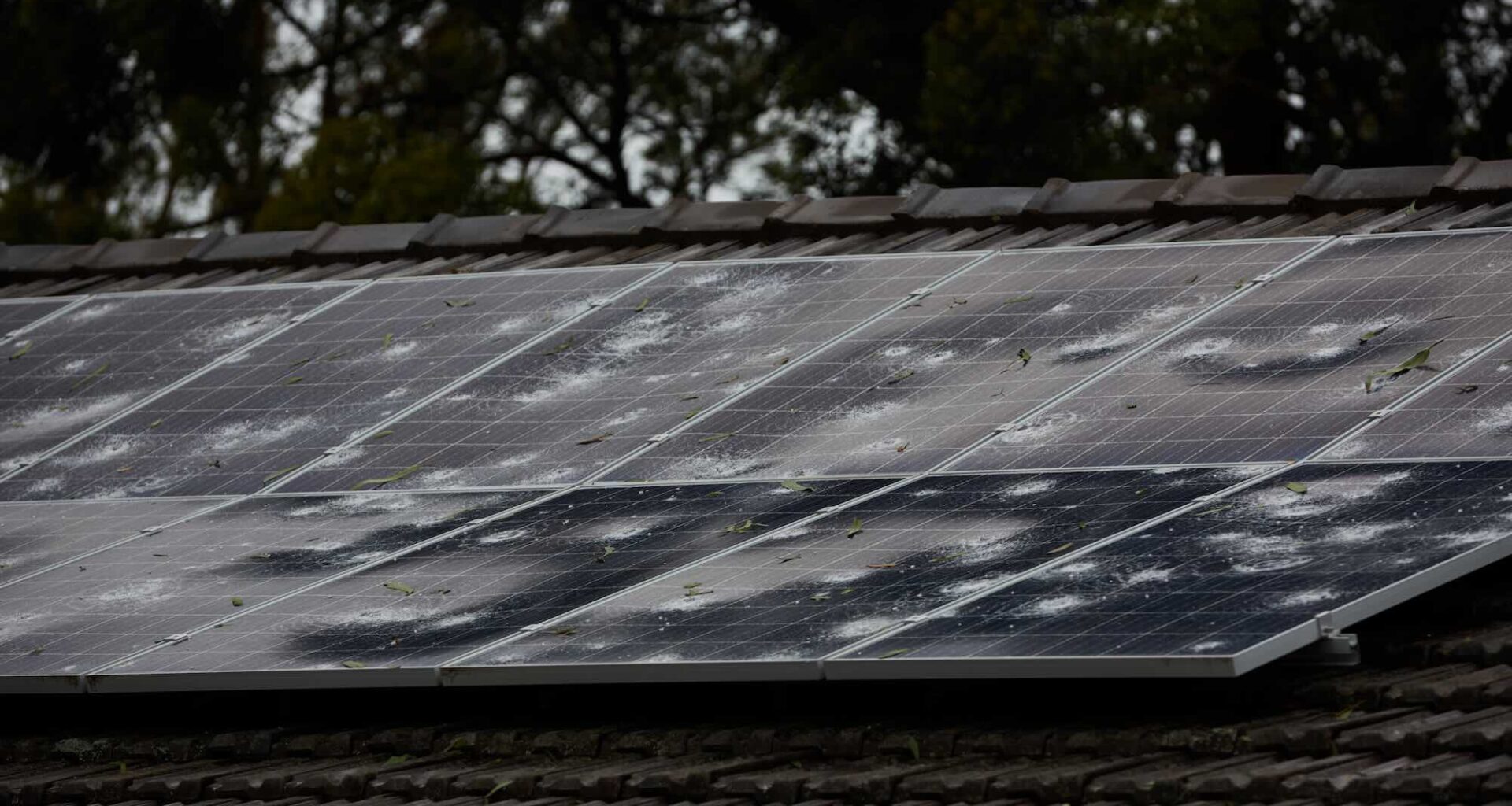Hailstones measuring as large as 9cm pelted south-east Queensland over the weekend, smashing rooftop solar arrays and threatening large scale installations – underlining the business case for a wave of anti-hail innovations to protect against bigger and wilder storms.
Hail is now a top priority for insurers in Australia because hailstones are getting bigger, says Andrew Percival, head of sales at Chinese solar panel manufacturing giant Trinasolar.
“The other day, we were at a forum… their concern is the amount of projects in the US [that are vulnerable to hail storms], but also here in some of our cyclonic regions where hailstones are becoming larger than the Australian Standard is currently approved for,” Percival told Renew Economy at the All Energy conference last week.
“The insurance companies like [the new panels designed to withstand bigger hailstones] because… they see the damage increasing, and they know that project sizes are becoming larger. So if hail wipes out 500 megawatts (MW), it becomes expensive.”
Percival says the company’s new Shield modules, when combined with tracking systems that can stow the panels in a protective position, can withstand 55mm hail “rocks”.
He also says one outcome from the recent forum is instead of putting more pressure on developers, the insurance industry will start looking to “get involved” in how panels are tested and to what level, with the International Electrotechnical Commission (IEC) and the Australian Standards body.
In 2023, the solar industry was concerned that insurers would stop insuring projects in hail-prone locations.
The current standard for solar panels is to withstand stones up to 35mm in diameter – much smaller than the giants lashing Queensland’s solar regions Toowoomba, Brisbane and Western Downs over the weekend.
Australia’s hail corridor is northern New South Wales (NSW) and north into Queensland. The country’s biggest recorded hailstone was 16cm in diameter in the sunshine state town of Mackay.
But those zones are set to expand, with bigger hail coming more often as climate change alters the severity of weather systems, according to research from UNSW in July.
“We looked at changes in hailstone size between simulations of historical and future periods,” said lead author Dr Tim Raupach from UNSW Sydney’s Institute for Climate Risk and Response, in a statement.
“And we can see increases in hail size produced by the model around Sydney, Canberra, Melbourne and Perth.
“For example, in past simulations, very large, 10 cm hailstones were expected once every 20 years around Melbourne. But in a warmer future, it’s once every three years.”
Trackers build up anti-hail tech
US tracking systems company Array is one of those pitching systems in Australia that can withstand bigger hailstones, combining a low-angled stow position with predictive weather software.
A low tilt angle reduces the amount of kinetic energy if it hits the front, and reduces the risk of damage.
The company’s Asia director, Michael Corio, says they’ve “come prepared” to de-risk projects by combining automating hail defense software with a tracker that can stow panels at an almost-vertical 77º angle from the ground.
“We’ve decided to address [the hail risk] with our hail alert response system that uses predictive hail weather data to move the trackers away from the direction of oncoming hail,” Corio told Renew Economy at the All Energy conference.
“It’s a fully automated response to protect the solar asset during those conditions. So in Australia we’ve been offering it to many customers [and the] take up is good.”
Corio says developers are becoming more aware of the issues with hail and the need to really properly plan for technology that can offer some protection for the ultimate project owners in future.
In April, Victoria-based renewables utility Flow Power said it would roll out anti-hail solar panels at its 6.14 MW Coonawarra Energy Project, an Australia-first from solar manufacturing giant Canadian Solar.
Forewarnings
Hail prediction is an issue Queensland-based meteorologist Anthony Cornelius has built a business on for both insurers and solar farm operators.
He showed off plastic, weighted models of the size of hailstones Queensland receives at his All Energy booth for the hailtracker.io software – terrifying lumps covered in spikes that fit comfortably into an adult’s hand that measure 8cm across.
The damage from hailstones that size does not come cheap, hence why insurers are taking a more proactive interest, but lost time and revenue from energy production as projects are offline for months of maintenance make a shift from total to partial loss a “no brainer”, Cornelius says.
“It’s absolutely in terms of, you know, I don’t want to have my soil farm damaged and so forth or out of action for six months, or I have to get someone in and examine every single panel,” he told Renew Economy.
“People are becoming more aware of the risk. Previously, it was a case of perhaps they were aware, but didn’t understand it. Even if the return rate [for a solar farm] is 10 or 15 years – our solar farm life cycle is going to be 30 or 40 years – having to replace panels every 10 to 15 years due to a hail storm, that’s not going to be economically viable.”
His software maps how the hail corridor through NSW and Queensland has changed over time and shows hail seasons starting earlier in August and finishing later in May.
Every five minutes it models the weather in Australia and forecasts where a hail storm is tracking over the next 30 minutes, enough of a window for clients to put panels into stow mode.

Rachel Williamson is a science and business journalist, who focuses on climate change-related health and environmental issues.


